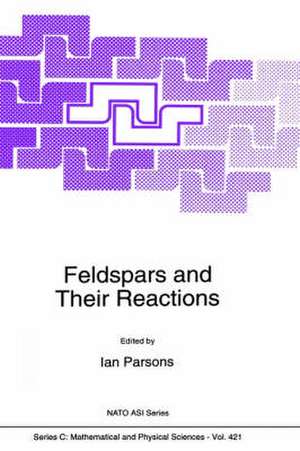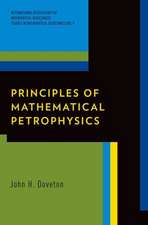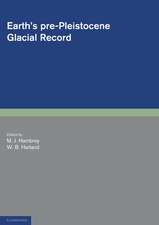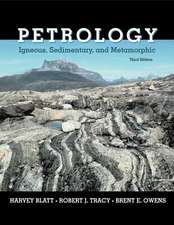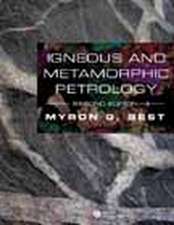Feldspars and their Reactions: Nato Science Series C:, cartea 421
Editat de Ian Parsonsen Limba Engleză Hardback – 28 feb 1994
| Toate formatele și edițiile | Preț | Express |
|---|---|---|
| Paperback (1) | 1834.10 lei 6-8 săpt. | |
| SPRINGER NETHERLANDS – 6 oct 2012 | 1834.10 lei 6-8 săpt. | |
| Hardback (1) | 1840.43 lei 6-8 săpt. | |
| SPRINGER NETHERLANDS – 28 feb 1994 | 1840.43 lei 6-8 săpt. |
Din seria Nato Science Series C:
- 24%
 Preț: 797.69 lei
Preț: 797.69 lei - 18%
 Preț: 957.62 lei
Preț: 957.62 lei - 18%
 Preț: 957.13 lei
Preț: 957.13 lei - 18%
 Preț: 1227.52 lei
Preț: 1227.52 lei -
 Preț: 396.40 lei
Preț: 396.40 lei -
 Preț: 403.75 lei
Preț: 403.75 lei - 18%
 Preț: 1239.37 lei
Preț: 1239.37 lei - 18%
 Preț: 1236.51 lei
Preț: 1236.51 lei - 18%
 Preț: 1231.78 lei
Preț: 1231.78 lei - 18%
 Preț: 1229.10 lei
Preț: 1229.10 lei - 18%
 Preț: 1835.21 lei
Preț: 1835.21 lei - 24%
 Preț: 1076.39 lei
Preț: 1076.39 lei -
 Preț: 390.46 lei
Preț: 390.46 lei -
 Preț: 369.63 lei
Preț: 369.63 lei - 18%
 Preț: 1232.41 lei
Preț: 1232.41 lei -
 Preț: 394.51 lei
Preț: 394.51 lei - 18%
 Preț: 1226.24 lei
Preț: 1226.24 lei - 18%
 Preț: 1845.80 lei
Preț: 1845.80 lei -
 Preț: 399.88 lei
Preț: 399.88 lei -
 Preț: 384.28 lei
Preț: 384.28 lei -
 Preț: 390.88 lei
Preț: 390.88 lei -
 Preț: 381.19 lei
Preț: 381.19 lei - 18%
 Preț: 1848.64 lei
Preț: 1848.64 lei - 18%
 Preț: 951.14 lei
Preț: 951.14 lei - 18%
 Preț: 1230.35 lei
Preț: 1230.35 lei - 18%
 Preț: 1236.51 lei
Preț: 1236.51 lei -
 Preț: 401.03 lei
Preț: 401.03 lei -
 Preț: 406.25 lei
Preț: 406.25 lei - 18%
 Preț: 1230.84 lei
Preț: 1230.84 lei -
 Preț: 418.34 lei
Preț: 418.34 lei - 18%
 Preț: 1223.74 lei
Preț: 1223.74 lei
Preț: 1840.43 lei
Preț vechi: 2244.43 lei
-18% Nou
Puncte Express: 2761
Preț estimativ în valută:
352.15€ • 367.72$ • 290.80£
352.15€ • 367.72$ • 290.80£
Carte tipărită la comandă
Livrare economică 16-30 aprilie
Preluare comenzi: 021 569.72.76
Specificații
ISBN-13: 9780792327226
ISBN-10: 0792327225
Pagini: 684
Ilustrații: XXX, 650 p.
Dimensiuni: 155 x 235 x 42 mm
Greutate: 1.13 kg
Ediția:1994
Editura: SPRINGER NETHERLANDS
Colecția Springer
Seria Nato Science Series C:
Locul publicării:Dordrecht, Netherlands
ISBN-10: 0792327225
Pagini: 684
Ilustrații: XXX, 650 p.
Dimensiuni: 155 x 235 x 42 mm
Greutate: 1.13 kg
Ediția:1994
Editura: SPRINGER NETHERLANDS
Colecția Springer
Seria Nato Science Series C:
Locul publicării:Dordrecht, Netherlands
Public țintă
ResearchCuprins
1. The Crystal Structures of the Aluminium-Silicate Feldspars.- Abstract.- 1. Introduction.- 1.1 Historical Perspective.- 1.2 Recent Progress and Overview.- 2. Chemistry of Feldspars.- 3. Topology of the Feldspar Framework.- 4. Patterns of Al, Si Order-Disorder: Space Groups.- 4.1 Alkali Feldspars.- 4.1.1 Monoclinic (C2/m) K-rich Alkali Feldspars.- 4.1.2 Triclinic ($$C\bar 1$$) K-rich Alkali Feldspars.- 4.1.3 Room-Temperature Phase Transition in Low Microcline?.- 4.1.4 Triclinic ($$C\bar 1$$) Anorthoclases, K-Analbites, and the Transition to C2/m Na-Sanidines.- 4.1.5 Triclinic ($$C\bar 1$$) Low, Intermediate, and High Albite.- 4.1.6 Analbite and the Transition to C2/m Monalbite.- 4.2 Celsian and Hyalophane.- 4.3 Anorthite and Intermediate Plagioclases.- 4.3.1 The ‘Aluminium Avoidance’ Principle and Al, Si order/disorder.- 4.3.2 Primitive Anorthite.- 4.3.3 Pseudo-symmetry and the Average Structure Concept.- 4.3.4 Body-centered Anorthite.- 4.3.5 Intermediate Plagioclases.- 5. The M Cations in Feldspar Structures.- 5.1 Potassium in Sanidines and Microclines.- 5.2 Sodium in Albites.- 5.2.1 Sodium in Low Albite.- 5.2.2 Sodium in High Albite and Monalbite.- 5.2.3 Sodium in Intermediate Albite (IA) and Na/Ca in Sodic Plagioclase.- 5.2.4 Ca/Na in Calcic Plagioclase.- 6. Average Structures of Feldspars Represented by Cell Parameters: the Temperature-Pressure-Composition Analogies.- 6.1 Changes in Volume with P, T, X.- 6.1.1 Compressibility and Phase Changes with Pressure.- 6.1.2 Thermal Expansion.- 6.1.3 Variation of Composition in ‘Solid-Solution’ Series.- 6.2 Changes in Cell Dimensions with P,T,X.- 6.2.1 Series of Na- and K- Mixed with Ca-, Sr-, and Ba-feldspars.- 6.2.2 The M2+-feldspars.- 6.2.3 Alkali Feldspars.- 6.3 Changes in T-O-T Angles and M-O Distances with P,T, X.- 6.3.1 Disordered Alkali Feldspars.- 6.3.2 Ordered Alkali Feldspars and the Structure of Low Albite at 5 GPa.- 7. Future Work.- References.- 2. Aspects of Alkali Feldspar Characterization: Prospects and Relevance to Problems Outstanding.- Abstract.- 1. Introduction.- 2 Light Optics.- 3. Composition and Lattice Strain.- 3.1 Composition of Unstrained Feldspars.- 3.2 Strained Feldspars.- 3.2.1 Background.- 3.2.2 Determination of Lattice Strain.- 3.2.3 Determination of Composition.- 3.3 Composition from K, Na Site Refinements of X-Ray Intensity Data.- 4. Determination of Tetrahedral Al Contents in Alkali Feldspars.- 4.1 T-Site Occupancies from Lattice Parameters.- 4.2 T-Site Occupancies from T-O Distances.- 4.3 T-Site Occupancies from Si, Al Site Refinements of X-Ray Intensity Data.- 5. Single-Crystal X-ray Diffraction Patterns and Relationships with TEM Techniques.- 5.1 The Diagonal Association.- 5.2 The Antidiagonal Association.- 5.3 P21/a Structural Arrangement.- 6. Unanswered questions and suggestions for future work.- Acknowledgements.- References.- 3. Phase Transitions and Vibrational Spectroscopy in Feldspars.- Abstract.- 1. Introduction.- 2. Phase Transitions and Order Parameters.- 2.1 The order Parameter.- 2.2 Coupling between order Parameters.- 2.3 Some Typical Landau Potentials.- 3. Kinetic and Other Non-Equilibrium Behaviour.- 4. Hard Mode Phonon Spectroscopy.- 4.1 Introductory Remarks on Optical Spectroscopy.- 4.2 Soft Modes Versus Hard Modes.- 4.3 The Characteristic Length Scale.- 4.4 How to Do It.- 5. Applications and Examples.- 5.1 Temperature Dependence of Hard Modes in Albite.- 5.2 Effect of the C2/m-$$C\bar 1$$ Transition in Anorthoclase.- 5.3 A Displacive Phase Transition with Some Fluctuations: $$P\bar 1 - I\bar 1$$ in Anorthite.- 5.3.1 Space Average Model.- 5.3.2 The Ca-jumping Model.- 5.3.3 Soft-mode Model.- 5.4 Determination of the Degree of Al, Si order in Na Feldspar.- 5.5 Structural Modulations in Natural Potassium Feldspar.- 5.6 On the Effect of Na-K Mixing and the Study of Exsolution: an Outlook.- Conclusion.- Acknowledgements.- Appendix 1.- Deviation of the Gibbs Free Energy for a Phase Transition with Continuous Local Potentials.- Appendix 2.- On the Intercorrelation of Al, Si Ordering and the Generation of Spontaneous Strain.- References.- 4. Partial Melting Reactions of Plagioclases and Plagioclase-Bearing Systems.- Abstract.- 1. Introduction.- 2. Previous Work on Plagioclase-melt Interaction.- 3. Starting Materials and Experimental Procedure.- 4. Experimental Results and Discussion.- 4.1 Dry Melting of Plagioclase An68 At 1420°C.- 4.2 Wet Melting of Plagioclase An P = 5 Kbar.- 4.3 The Influence of Additional Components and Phases.- 4.3.1 Melting Reactions in the System Qz-Ab-An-H2O.- 4.3.2 Melting Reactions in the System Qz-Ab-An-Al2O3-H2O.- 4.3.3 Melting Reactions in the System Qz-Or-Ab-An-H2O.- 4.3.4 Kinetics of partial melting in systems with additional SiO2-containing phases beside feldspars.- 5. Summary.- Acknowledgements.- References.- 5. Ternary Feldspar/Melt Equilibria: A Review.- Abstract.- 1. Introduction.- 2. Ternary Feldspar Geothermometry.- 2.1 Activity Models for Ternary Feldspar Solid Solutions.- 2.2 Geothermometry: Calculation Methodology and Results.- 3. Ternary Felspar/Melt Equilibria.- 3.1 Liquidus Relations in the Feldspar System.- 3.2 Compositional Evolution of Feldspars during Crystallization.- 3.2.1 Equilibrium Crystallization.- 3.2.2 Fractional Crystallization.- 4. Conclusions.- 5. Acknowledgements.- 6. References.- 6. Subsolidus Phase Relations of the Plagioclase FeldsparSold) Solution.- Abstract.- 1. Introduction.- 2. A Possible Phase Diagram.- 3. Lines of Evidence.- 3.1 Order/disorder Experiments.- 3.1.1 C2/m = $$C\bar 1$$ Transition.- 3.1.2 $$C\bar 1 - I\bar 1$$ Transition.- 3.1.3 $$I\bar 1$$ = e1 Transition.- 3.1.4 $$C\bar 1$$ = e2 Transition.- 3.1.5 Ordering within the C1 stability field.- 3.1.6 $$I\bar 1 = P\bar 1$$ Transition.- 3.1.7 Summary.- 3.2 Microstructures.- 3.2.1 Peristerite gap.- 3.2.2 Bøggild gap.- 3.2.3 Huttenlocher gap.- 3.3 Compositions of Coexisting Crystals.- 3.3.1 Coexisting Phases across the Peristerite Gap.- 3.3.2 Coexisting Plagioclases with Intermediate Compositions.- 3.3.3 The Low Temperature Assemblage Albite + Anorthite.- 3.4 Properties of the Incommensurate “e” Structure.- 3.4.1 Mestable Incommensurate Structure of Anorthite.- 3.4.2 Structure of “e” Plagioclase.- 3.4.3 Influences of Temperature and Composition.- 3.4.4 Distinction between e1 and e2 Structures.- 3.5 Thermodynamic Data.- 3.5.1 Enthalpies of Ordering and Mixing.- 3.5.2 Energetics of Antiphase Boundaries.- 3.5.3 Ion-exchange Data.- 3.6 Kinetic Constraints.- 4. The Rudiments of a Thermodynamic Model.- 4.1 Schematic G-X Curves.- 4.2 Landau Free Energy Expansions.- 5. Conclusion.- 5.1 Al/Si Ordering At An0 - An15.- 5.2 Local Ordering in the Cl Solid Solution.- 5.3 Microstructural Evidence for Split Behaviour At ~An52.- 5.4 $$C\bar 1$$ = e2 Transition Temperatures.- 5.5 The $$I\bar 1$$ = e1 Ordering Transition.- 5.6 Thermodynamics of Incommensurate Ordering.- 5.7 Incommensurate Structures and Differences between e1 And e2 Ordering.- 5.8 Phase Equilibrium and Ion-Exchange Experiments.- Acknowledgements.- References.- 7. Feldspars at High Pressure.- Abstract.- 1. Introduction.- 2. Stability of Feldspars at High Pressure.- 2.1 Albite.- 2.2K-Feldspar.- 2.3 Anorthite.- 3. Compressional Behaviour.- 3.1 Bulk Moduli.- 3.2 Unit Cell Parameter Variation with Pressure.- 3.3 Strain Tensors.- 4. Structural Phase Transitions.- 4.1 Phase Transitions in Alkali Feldspars.- 4.2 $$P\bar 1$$ to $$I\bar 1$$ Transition in Anorthite.- 4.2.1 $$P\bar 1$$ = $$I\bar 1$$ in End-Member Anorthite.- 4.2.2 Effect of Al, Si Disorder on $$P\bar 1$$ = $$I\bar 1$$.- 4.2.3 Effect of Albite Substitution on $$P\bar 1$$ = $$I\bar 1$$ Transition.- 4.2.4 Phase Diagram for Anorthite $$P\bar 1$$ = $$I\bar 1$$ Transition.- 4.2.5 Thermodynamic Analysis.- 4.3 Phase Transitions in Other Feldspars.- 4.4 Conclusions.- 5 Acknowledgements.- 6. References.- 8. Recent Work on Oscillatory Zoning in Plagioclase.- Abstract.- 1. The Problem.- 2. Empirical Observations of Zoning.- 2.1 Hypotheses and Assumptions.- 2.1.1 Crystal Growth.- 2.1.2 Analysis of Zoning Patterns.- 2.2 Trace Elements and Disequilibrium.- 2.3 Discussion of Plates.- 2.3.1 Plate 1.- 2.3.2 Plate 2 “Corners”.- 2.3.2 Plate 3 “Interfaces”.- 2.4 Conclusion from Empirical Observations.- 2.4.1 The Consequences of Saw-toothed Patterns.- 2.4.2 Significance of Dissolution.- 2.4.3 Constraints on Growth Mechanisms and Laws.- 3. Spatiotemporal Dynamics in Oscillatory Zoning.- 3.1 Introduction.- 3.2 Theoretical Rationale.- 3.3 Empirical Textural Evidence.- 3.4 Identification of Chaotic Growth.- 3.4.1 General Comments.- 3.4.2 Random Zoning Patterns.- 3.4.3 Real Crystal Zoning Patterns.- 4. Attempts at Modelling Zonation.- 4.1 Theoretical and Empirical Models.- 4.2 Details of Models.- 4.2.1 Sibley et al (1976).- 4.2.2 Haase et al (1980).- 4.2.3 Allègre et al (1981).- 4.2.4 Lasaga (1982).- 4.2.5 Loomis (1979, 1982).- 4.2.6 Simakin (1983).- 4.2.7 Ghiorso (1987).- 4.2.8 Pearce (1993).- 4.2.9 Wangand Merino (1993).- 5. Discussion and Conclusions.- 5.1 General Comments.- 5.2 Preferred Model.- 5.3 Suggestions for Further Work.- 6. Acknowledgements.- 7. References.- 9. Isotopic Equilibrium/disequilibrium and Diffusion Kinetics in Feldspars.- Abstract.- 1. Introduction.- 1.1 Isotope Fractionation.- 1.2 Diffusion Measurement.- 1.3 Terminology.- 1.4 Applications.- 2. Part 1. Experiments and Theory.- 2.1 Oxygen Diffusion Kinetics.- 2.1.1 Hydrothermal Experiments.- 2.1.2 Dry Experiments.- 2.2 Cation Diffusion Kinetics.- 2.2.1 Strontium Diffusion.- 2.2.2 Other Cations.- 2.2.3 K-feldspars.- 2.2.4 Systematics of Cation behaviour.- 2.3 Prediction of D Values.- 3. Part 2. Applications of Diffusion Kinetics to Tectono-Thermal Histories.- 3.1 Oxygen Isotopes and the Rates of Cooling from High Temperatures.- 3.2 Rb-Sr Systematics and Cooling Rates from High Temperature.- 4. Conclusions.- Acknowledgements.- References.- 10. Hydrogen in Feldspars and Related Silicates.- Abstract.- 1. Introduction.- 2. Abundances and Substitution Mechanisms of Structural “Water”.- 2.1 Chemical Analysis.- 2.2 Spectroscopic Constraints.- 3. Early Studies and Models.- 3.1 Oxygen Isotope Exchange Experiments.- 3.2 Al-Si order-Disorder and Interdiffusion Experiments.- 4. The Question of Solution-Reprecipitation vs Solid-State Diffusion.- 5. Al-Si Order-Disorder and Interdiffusion in Feldspars as a Guide to the Role of Hydrogen.- 6. The Role of Hydrogen in Oxygen Diffusion in Felspars.- 6.1 Introduction.- 6.2 First order Effects: Wet versus Dry Oxygen Diffusion.- 6.3 Second Order Effects: P(H2O)?.- 6.3.1 Experimental Problems.- 6.3.2 Interdependence of Variables in H2O-bearing Systems.- 6.3.3 Discussion.- 7. The Effect of Water on Cation Diffusion.- 8. Properties of Eifel Sanidine: A NaturalExample of the Catalytic Role of Hydrogen in Feldspars?.- 9. Hydrogen in Feldspars: Conclusions and Prospects of Future Progress.- 10. Footnote: Water in Feldspars at High P(H2O), and Feldspar Hydrates.- Acknowledgements.- References.- 11. Argon Diffusion in Feldspars.- Abstract.- 1. Introduction.- 1.1 Perspective.- 1.2 Scope.- 2. Background.- 2.1 40Ar/39Ar Technique.- 2.1.1 Some Basics.- 2.1.2 Dating of Feldspars.- 2.1.3 Effects of Neutron Irradiation.- 2.2 Diffusion of Argon.- 2.2.1 General.- 2.2.2 Temperature Dependence.- 2.2.3 Measurements and Models.- 2.3 Diffusion and the 40Ar/39Ar Techniques.- 2.3.1 Closing Temperature.- 2.3.2 Argon Gradients.- 3. Brief Review of Selected Feldspar Argon Studies.- 3.1 Overview.- 3.2 Early Diffusion Studies.- 3.3 40Ar/sAr Studies.- 4. Defining the Parameters of Ar Diffusive Transport in Feldspar.- 4.1 Behavior in Benson Mines Orthoclase.- 4.1.1 Specimen.- 4.1.2 Behavior of Ar in Natural Material.- 4.1.3 Behavior of Ar in Irradiated Material.- 4.1.4 Behavior of Ar in Incremental-Heating Experiments.- 4.2 Generalizations.- 4.2.1 Diffusion Following “Fickian” Behavior.- 4.2.2 Anisotropy of Ar Transport.- 4.2.3 Effect of External Atmospheres.- 4.2.4 Effects of Neutron Irradiation.- 4.2.5 Diffusion Mechanisms.- 4.2.6 Sites of Argon.- 4.2.7 Effect of Twin and Lamellar Boundaries.- 4.2.8 Intrinsic versus Extrinsic Control.- 4.2.9 Argon Trapping.- 4.2.10 Applicability to Nature.- 5. References.- 12. Feldspars in Igneous Rocks.- Abstract.- 1. Introduction.- 2. Conditions of Crystallization and Alteration of Feldspars in Rocks.- 2.1 The Feldspathic Component of Magmas.- 2.2 The Effect of Emplacement Conditions on Nucleation and Growth.- 2.2.1 Nucleation.- 2.2.2 Growth.- 2.3 Intracrystalline Textures and Chemical Zoning.- 2.4 EquilibriumPhase Relationships.- 2.5 Equilibrium and Fractional Crystallization.- 2.6 Phase-Transformation and Exsolution Micro- Textures.- 2.7 Deuteric and Hydrothermal Alteration.- 2.8 Deformation and Uplift.- 3. Feldspar in the Classification of Igneous Rocks.- 3.1 The Modal Iugs Classification Scheme.- 3.2 The Chemical Tas Diagram.- 3.3 Normative Plagioclase Compositions and Classification Schemes.- 4. Feldspars in Volcanic and Hypabyssal Rocks.- 4.1 Structures and Textures in Volcanic Rocks.- 4.1.1 Structures in Volcanic Rocks.- 4.1.2 Volcanic Intercrystalline Textures.- 4.1.3 Volcanic Intracrystalline Textures.- 4.2 Zoning Paths in Volcanic Feldspars.- 4.2.1 One-Feldspar Paths--Plagioclase.- 4.2.2 One-Feldspar Paths — Sanidine.- 4.2.3 Simultaneous Two-Feldspar Paths.- 4.2.4 Sequential Two-Feldspar Paths.- 4.2.5 Critical Solution Line.- 4.3 Volcanic Subsolidus Transformation and Exsolution Microtextures.- 4.3.1 Anorthoclase.- 4.3.2 Cryptoperthites.- 5. Feldspars in Plutonic Rocks.- 5.1 Structures and Textures in Plutonic Rocks.- 5.1.1 Structures in Plutonic Rocks.- 5.1.2 Plutonic Intercrystalline Textures.- 5.1.3 Plutonic Intracrystalline Textures.- 5.2 Zoning Paths in Plutonic Feldspars.- 5.3 Plutonic Subsolidus Transformation and Exsolution Microtextures.- 5.3.1 Plagioclase.- 5.3.2 Ternary and Alkali Feldspars in Hypersolvus Rocks.- 5.3.3 Alkali Feldspars in Subsolvus Rocks.- 6. Deuteric Alteration of Feldspars and Low-Temperature Reactivity.- 6.1 Deuteric Microtextural Changes in Alkali Feldspars.- 6.2 Geochemical Implications and Temperatures of Deuteric Reactions.- 7. Acknowledgements.- 8. References.- 13. Evolution of Feldspars in Granitic Pegmatites.- Abstract.- 1. Introduction.- 2. Terms of Reference.- 3. Paragenetic and Textural Relationships.- 3.1 ZonedPegmatites.- 3.2 Other Structural Types.- 3.2.1 Layered Pegmatites.- 3.2.2 Quasi-homogeneous Pegmatites.- 3.2.3 The Albite Type.- 3.2.4 Miarolitic Pegmatites.- 4. Compositional Evolution at the Magmatic Stage.- 4.1 Trends in Bulk Composition.- 4.2 Minor Elements in K-Feldspar.- 4.3 Minor Elements in Plagioclase.- 4.4 Fractionation Trends of Minor Elements.- 5. Isotopic Data.- 6. Subsolidus Processes.- 6.1 Evolution of K-Feldspar.- 6.1.1 Ordering - Structural and Textural Aspects.- 6.1.2 Perthitic Exsolution and Coarsening.- 6.2 Evolution of Plagioclase.- 6.2.1 Ordering.- 6.2.2 Exsolution.- 6.3 Low-Temperature Hydrothermal Phases.- 7. Replacements involving Feldspars.- 7.1 Albite-Rich Units.- 7.2 Micaceous Units.- 8. Concluding Remarks.- Acknowledgements and References.- 14. Surface Chemistry of Feldspars.- Abstract.- 1. Introduction.- 2. Quantitative Chemical and Physical Theories.- 2.1 Electronic Theories of Bulk Crystal Structure.- 2.2 Thermodynamic Concepts.- 2.3 Acid-Base Behavior.- 2.4 Defects.- 3. General Ideas on Surfaces.- 3.1 Growth Morphology and Surface Properties.- 3.2 Hydroxyls, Terminal Oxygen Atoms and Water Molecules.- 3.3 Inorganic Ions and Complexes.- 3.4 Organic Ions and Complexes.- 3.5 Ultra-High Vacuum.- 3.6 High- and Low-Temperature; High Pressure.- 4. Atomic Packing at Feldspar Surfaces.- 4.1 Hydrogen-Free Termination of Regular Structure.- 4.2 Hydrogenated Surface.- 4.3 Inorganic Adsorb Ates.- 4.4 Organic Adsorbates.- 5. Analytical Techniques and Results on Feldspars, Clays, Zeolites, etc..- 5.1 Introduction.- 5.2 Microscopy.- 5.2.1 General.- 5.2.2 Atomic force microscopy.- 5.2.3 Electron microscopy.- 5.2.4 X-ray Microscopy.- 5.2.5 Angular Distribution Auger Microscopy.- 5.3 Chemical Microanalysis Using a Narrow Beam.- 5.3.1 General.- 5.3.2 Secondary Ion Mass Spectrometry.- 5.3.3 Electron-excited X-ray Emission Analysis.- 5.3.4 X-ray Fluorescence Analysis.- 5.3.5 Nuclear Analysis.- 5.4 Diffraction.- 5.4.1 General.- 5.4.2 Electron Diffraction.- 5.4.3 X-ray Diffraction.- 5.4.4 Neutron Diffraction.- 5.5 Spectroscopy and Resonance.- 5.5.1 General.- 5.5.2 Infrared, Raman, & Luminescence Spectroscopies.- 5.5.3 Electron- and X-ray-induced Photoelectron & X-ray Spectroscopies.- 5.5.4 X-ray Absorption Spectroscopies.- 5.5.5 Ultraviolet Spectroscopy.- 5.5.6 Nuclear Magnetic Resonance.- 5.5.7 Electron Paramagnetic Resonance.- 5.5.8 Ion Scattering Spectroscopy.- 5.6 Chemical Analysis Using Classical Methods.- 5.6.1 Adsorption.- 5.6.2 Titration.- 6. Speculations on Surface Properties of Feldspars in Various Geological Environments and Ideas for Future Research.- 6.1 Are Silanol-Rich Surfaces Responsible for Slower Weathering in Nature than Experimental Alteration?.- 6.2 How Do Feldspars in Soils Interact with Natural Organics and Microbes?.- 6.3 Biological Evolution: Absorption on Grooved Surfaces of Feldspars.- 6.4 Surface Properties of Feldspar in High-Pressure Rocks.- 6.5 Surface Properties of Extraterrestrial Feldspars.- 6.6 Transition-Metal Complexes on Feldspar Surfaces.- 6.7 Surface Infrared Spectroscopy of Feldspar.- 6.8 Surface X-Ray Absorption Spectroscopy and Diffraction.- 6.9 Neutron Diffraction of Hydrogen-Feldspar.- 6.10 Sims of Exchange Processes at Feldspar Surfaces.- 7. Acknowledgements.- 8. References.- 15. Feldspars in Weathering.- Abstract.- 1. Introduction.- 2. Experimental Determination of Feldspar Dissolution Rates.- 2.1 Transport versus Surface Reaction Control.- 2.2 Feldspar Surface Areas.- 2.3 Initial Adsorption/exchange Reactions.- 2.3.1 Surface Titrations.- 2.3.2 Surface Complexes on Feldspars.-2.4 Rapid Initial Dissolution Rates.- 2.5 Steady-State Feldspar Dissolution Rates.- 2.5.1 Experimental Techniques.- 2.5.2 Albite Dissolution Kinetics.- 2.5.3 Potassium Feldspar Dissolution Kinetics.- 2.5.4 Plagioclase Dissolution Kinetics.- 2.5.5 Reproducibility of Feldspar Dissolution Rates.- 2.5.6 Evidence for a Leached Layer on the Surface.- 3. Theoretical Approaches to Surface Reaction Controlled Dissolution Kinetics.- 3.1 Atomistic Models.- 3.2 Surface Speciation Models.- 3.2.1 Applications of Surface Speciation Models to Feldspar Dissolution Kinetics.- 3.2.2 Implications of Surface Speciation on Temperature Effects.- 3.3 Macroscopic Models.- 3.3.1 Surface Nucleation Models.- 3.3.2 Dissolution at Dislocations.- 3.3.3 Numerical Models of Dissolution Kinetics.- 4. Field Measurements of Feldspar Weathering Rates.- 5. Summary.- 5.1 Experimental Data.- 5.2 Feldspar Dissolution Mechanisms.- 5.2.1 Feldspar Dissolution in the Acid Region.- 5.2.2 Feldspar Dissolution in the Basic Region.- 5.2.3 Weathering Rates of Feldspars.- 6. References.
